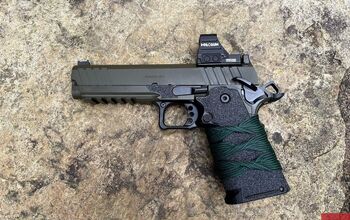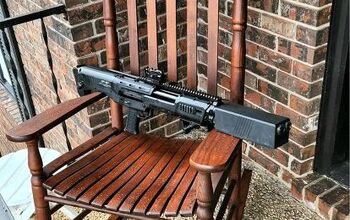Fudd Friday: The Remington 550-1's Useful Floating Chamber

FUDD FRIDAY: Remington 550-1's Floating Chamber – Over-Engineering Actually Made Sense
In the firearms world, there's a certain breed of enthusiast often labeled a "Fudd" – that old-timer at the range who insists his wooden-stocked rifle from the Truman administration is superior to your modern plastic fantastic. While some are quick to roll their eyes at claims that "they don't make 'em like they used to," sometimes the old guard has a point. The Remington 550-1 is one of those rare cases where complicated old-school engineering actually delivered something genuinely special.
Fudd Friday @TFB:
- Fudd Friday: Is .303 British The Ultimate Fudd Cartridge?
- Fudd Friday: Stevens 325 - When Bolt Actions Met .30-30
- Fudd Friday: Winchester 1911 SL - Was the "Widowmaker" Really Deadly?
- Fudd Friday: Remington's Model 8 And Model 81 Were Weird And Wonderful
- Fudd Friday: Colt's 1911 Competition Government Review
The Triple-Threat .22 That Actually Worked
Manufactured from 1941 to 1970, the Remington 550-1 wasn't just another .22 plinker – it was a legitimate engineering marvel that solved a problem most firearms designers don't even bother attempting: true multi-cartridge compatibility. The 550-1 could reliably cycle .22 Short, .22 Long, and .22 Long Rifle without any adjustment whatsoever.
This wasn't accomplished through simple design – it was achieved through what might be the most over-engineered semi-auto action ever created for a rimfire: the floating chamber.
What Is A Floating Chamber Anyway?
If you've never handled a 550-1, you might wonder what makes its action different from your standard blowback .22. At the heart of this mechanical wizardry is what essentially amounts to a separate steel sleeve that surrounds the cartridge in the chamber and moves independently within the bolt assembly.
When fired, this sleeve moves rearward slightly before the bullet exits the barrel, harnessing more energy from even the anemic .22 Short to reliably cycle the action. It's essentially an intermediate recoil transmission system that effectively harnesses energy to ensure reliable extraction and feeding.
Why create a floating chamber when you could just optimize for one cartridge? Because that's not how they rolled back then. Remington engineers didn't take the easy way out – they solved the problem completely.
When Versatility Actually Mattered
In post-war rural America, this versatility wasn't a marketing gimmick – it was genuinely practical. Imagine you're a farmer in the 1950s. The local general store might have .22 Shorts one month and Long Rifles the next. Your Remington 550-1 doesn't care – it eats them all with equal enthusiasm. With approximately 700,000 rifles produced over its lifespan, clearly this feature resonated with practical-minded shooters.
The tube magazine could hold up to 15 rounds of .22LR or a staggering 22 rounds of .22 Short – an impressive capacity for its time and something owners often bragged about.
The floating chamber concept wasn't created as a marketing tactic. It was developed to solve a legitimate mechanical challenge: how to extract maximum reliability from rimfire cartridges while maintaining smooth semi-automatic function across dramatically different loadings.
This is one area where the so-called "Fudd" mentality deserves some respect. The 550-1 wasn't over-engineered to justify a premium price tag – it was designed that way because it was the correct solution to the problem at hand.
As .22 Long Rifle ammunition became standardized as the rimfire cartridge of choice in post-war America, the 550-1's multi-cartridge flexibility gradually became less of a selling point. Features like the Ruger 10/22's rotary magazine and modern styling began to appeal more to shooters than the ability to shoot three different cartridge types.
Reliability That Stands The Test Of Time
Perhaps the most "Fudd" quality worth celebrating about the 550-1 is its long-term reliability. Many 550-1s are still functioning perfectly today, more than half a century after production.
The biggest maintenance requirement? Keep that floating chamber clean. Most owners note that the floating chamber gets dirty and wears out easily, with the simple solution being to clean it regularly. With proper maintenance, it can feed and cycle all kinds of .22 caliber rounds, including subsonic ammunition.
The rifle's robust construction contributed to its durability, making it a trustworthy tool on farms and ranches where reliability mattered more than fashion.
What might look like just another old-school plinker actually represents a unique approach to firearms engineering that deserves recognition. When we dismiss older firearms as obsolete relics, we risk overlooking the genuine innovation they represent.
The 550-1 occupied a somewhat premium position in the market with its traditional quality construction at a time when manufacturing methods were changing. In 1971, Remington discontinued the 550-1, replacing it with the Model 552 – a similar design that maintained the multi-cartridge capability but used more modern manufacturing techniques and materials. Many collectors and enthusiasts consider the change a downgrade, as the 552 never quite captured the robust quality that made the 550-1 special.
The Last Word
You know what the 550-1 represents? Engineering without compromise. It's what happens when the solution matters more than the production cost.
Nobody today would design a rimfire with a floating chamber. Too expensive, too complicated, not enough marketing appeal. But nobody today makes a semi-auto .22 that runs three different cartridge types without complaint, either.
So next time some range know-it-all smirks at your "outdated" Remington, just smile and load up 22 rounds of .22 Short. Some lessons in engineering excellence are best taught through demonstration. And if that makes me sound like a Fudd, well, I'll wear that badge proudly – at least until next Friday.

Staff Writer: TheFirearmBlog & AllOutdoor.com | Certified Gunsmith | Published Author | Firearm History Enthusiast
More by Sam.S
























![[SHOT 2025] RISE Armament RA-100 Two-Stage AR-15/AR-10 Trigger](https://cdn-fastly.thefirearmblog.com/media/2025/01/23/12371/shot-2025-rise-armament-ra-100-two-stage-ar-15-ar-10-trigger.jpg?size=350x220)


![[SHOT 2025] DSA x H&R Collab On T-48 FAL Clone](https://cdn-fastly.thefirearmblog.com/media/2025/01/21/23291/shot-2025-dsa-x-h-r-collab-on-t-48-fal-clone.jpg?size=350x220)


Comments
Join the conversation
Not a semi auto, but I have a Mossberg 46Ma bolt action from about 1945 that holds 22 Short, 17 long or 15 Long Rifle. Now the the interesting part: it is a controlled feed 22 rimfire-did not even think something like that was possible. Just like magic, when the shell casing is ejected a new cartridge is instantly on the head of the bolt ready to feed directly into the chamber. My Mossberg semi auto 151m's (LR only) are unique in that the new cartridge 'flies directly into the chamber with no assist from the bolt. There are a lot of old school designs that are unique. All of my old Mossberg guns are also incredibly accurate-dime size groups at 50 yards with bulk ammo.
The article fails to mention that David Marshall Williams invented and patented the floating chamber. He is best remembered for inventing the short-stroke piston while in prison for murder. This operating system was incorporated into the M1 carbine.